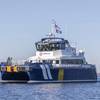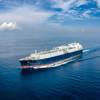By Larry Pearson
It seems to be a soap opera without an end. "It is crazy…makes no sense at all," is a common observation. If you are in the oil and gas business, the number one question is, "When is the drilling going to pickup?" It is a question without an answer…at least through the first quarter of 2004.
"Normally when prices are low and oil rises about $25 a barrel and gas goes above $2.50 per million cubic foot, everybody goes back to work," noted Roy Breaux, Jr., president of Breaux Bay Craft, Loreauville, La. a leading builder of crew/supply boats. "We drill ourselves out of recessions, but not this time, at least not yet" Breaux said.
Breaux echoes the sentiment of almost everyone in the industry "The answer must lie in Houston because that's where the decisions on when to drill come," Breaux said.
Houston is the home of the major oil company operations for the Gulf of Mexico and also home for many contract drillers who do the drilling work for oil companies.
"I've quit trying to predict when this thing is going to end," said Bob Alario, president of the Offshore Marine Service Association, an organization of offshore boat owners and equipment suppliers.
The importance of new drilling activity in the Gulf of Mexico cannot be over estimated for the health of the marine segment of offshore oil industry. The oil/gas companies and their contract drillers sit at the top of the offshore industry food chain. Drilling activity supports the use of supply boats and crew supply boats. When drilling activity is static or down, an unpleasant series of events play out in the offshore marine industry. First with fewer runs to the rigs and production platforms, vessel operators start "cold stacking" some of the boats in their fleet. With extra boats on hard there is no reason to build more, nor repair those in need.
An accompanying article details how lackluster drilling has led to a slowdown in the acquisition plans of the major offshore boat owners and the subsequent impact on the order books of Gulf Coast shipbuilders. And of course, the ripple impact of boats not being built affects engine manufacturers, gear companies and the manufacturers and distributors of thousands of products and systems used on today's modern OSVs.
The statistics behind this slowdown are most illuminating. Day rates and fleet utilization are the most critical yardsticks on how the offshore vessel market is performing and the news is not encouraging. Fleet utilization or the percentage of vessels working is down for anchor handlers, supply boats and crew/supply boats. Most all of these vessels were working in December 2002. A year later fleet utilization varies from 69 to 90 percent depending on type of vessel
Day rates or the average charter rate on a vessel per day is down even more. Anchor handlers that were fetching an average of $15,000 per day in 2002, brought less that $10,000 a day a year later. Large supply boats that averaged over $9,000 per day in December 2002 now attract less than $6,000 a day. Only crew/supply boats are holding their own.
What is Hot?
If oil companies are not drilling for new oil and gas, just what are they doing out there besides pumping oil and gas deep under the Gulf of Mexico? It is for sure they are investing in pipelines, tiebacks, communications equipment and other subsea construction projects to increase the efficiency of their oil and gas gathering systems. It is like investing money in remodeling or expanding an existing house rather than buying a new one.
Again statistics tell a revealing story on what is happening in the North American Offshore market. Pipeline construction activity is growing, especially in deepwater Gulf of Mexico. The installation of subsea trees (a device that sits on a well head to control pressure and monitor the flow of hydrocarbons out of the well) will be on the rise over the next few years. So too, will the miles of pipelines, umbilicals and flowlines. (Flowlines are small pipelines that carry hydrocarbons from the wellhead to an above water structure. Pipelines carry the hydrocarbons from a platform to facilities for more processing and umbilicals carry electrical, hydraulic and chemical products from platform to platform.
Vessel operators that have the equipment to lay flowlines, pipelines and umbilicals, especially in deepwater, will certainly be in demand over the next few years. One company that is adding vessels to its subsea construction fleet in anticipation of this trend is Torch Offshore, Inc. Gretna, La.
"We think this is a $15 billion market over the next five years," said Lyle Stockstill," president and CEO of Torch Offshore.
Torch introduced the Midnight Wrangler and the Midnight Hunter to its fleet in 2003. The former vessel specializes in deepwater pipe laying operations and deepwater crane work such as installation and removing trees. while the latter vessel specializes in supporting diving operations. Both vessels have been busy with significant subsea construction work such as pipeline/flowline and umbilical laying and mattress laying. (Mattresses are preformed concrete mats that are used to protect pipelines where they cross each other on the seabed.) The Midnight Wrangler deploys a 200 HP SonSub ROV to provide the eyes and hands for subsea construction work.
Not all of the Gulf of Mexico is in a drilling malaise. There is significant activity today in the Mexican Gulf of Mexico. The Mexican oil patch "is the hottest on the planet right now," according to Brett Candies, traffic manager of the US boat operating giant Otto Candies LLC, Des Allemands, La. The Candies firm has been way ahead of the curve on recognizing business opportunities in Mexico. Decades ago they formed a joint venture with Oceanografia S.A.de C.A. of Campche, Mexico and since 2000 have moved considerable vessel assets to Mexico. While many of these vessels were built in Holland, two crew boats were built in the U.S. And foreign flagged.
"We have reflagged one of our new builds, the 187-ft. supply boat Milissa Candies to Mexico because the vessel is on a long term contract," Candies said. "We may do the same thing to an identical new build if we get the contract we are pursuing," Candies added.
Vessels are normally reflagged on long-term contracts of five years or more, but stay with the U.S. flag if the project is a short term one of a few months, according to Candies.
Several other Candies vessels built by Shipyard De Hoop in the Netherlands are now working in Mexico and so is a pair of crew/supply vessels built by Austal USA, Mobile, Ala.
According to ODS-Petrodata, there are 13 fewer rigs working in the U.S. Gulf of Mexico and most of those rigs will be moving to Mexico. Further good news on Mexican activity comes from a report from Jefferies & Company in Houston that, in part, said," Several vessel companies have been bidding aggressively on work in Mexico where further increases in offshore and drilling activity are expected to require up to 30 additional OSV's over the next 12-24 months."
"It appears that our business plan for Mexico was on the money," Candies said.
One problem working in Mexico is that it is difficult to secure work in Mexico without having worked there previously, according to Tom Marsh of ODS-Petrodata. With the decades of experience, Oceanografia/Candies has in the area; they are expected to have all the work they can handle.n Other industry boat operators will also try to cash in on the boom market in Mexico shifting some of their unused vessels to Mexico.
Also of note is the shifting of U.S. built vessels to other offshore production regions in South America, Africa and other spots around the globe. For example, Tidewater had four 175-foot crew/supply vessels built by C & G Boat Works, Mobile, Ala. last year. "Two of those vessels were returned to us to add two new staterooms in the hull," said Mickey Cook, general manager of C & G. The new staterooms gave the vessels the ability to carry four additional crew, a needed feature for their foreign assignments. For much of 2004 it appears that the eastern and central Gulf of Mexico will continue its slow recovery from the drilling malaise it has been mired in over the past two years. Technology may help the market recover as deepwater drilling continues set new water depth records. The Transocean Inc. drill ship Discoverer Deep Seas spudded a well in 10,011 feet of water in December 2003 while working on Chevron/Texaco's Alaminos Canyon project.
Subscribe for
Maritime Reporter E-News
Maritime Reporter E-News is the maritime industry's largest circulation and most authoritative ENews Service, delivered to your Email five times per week










